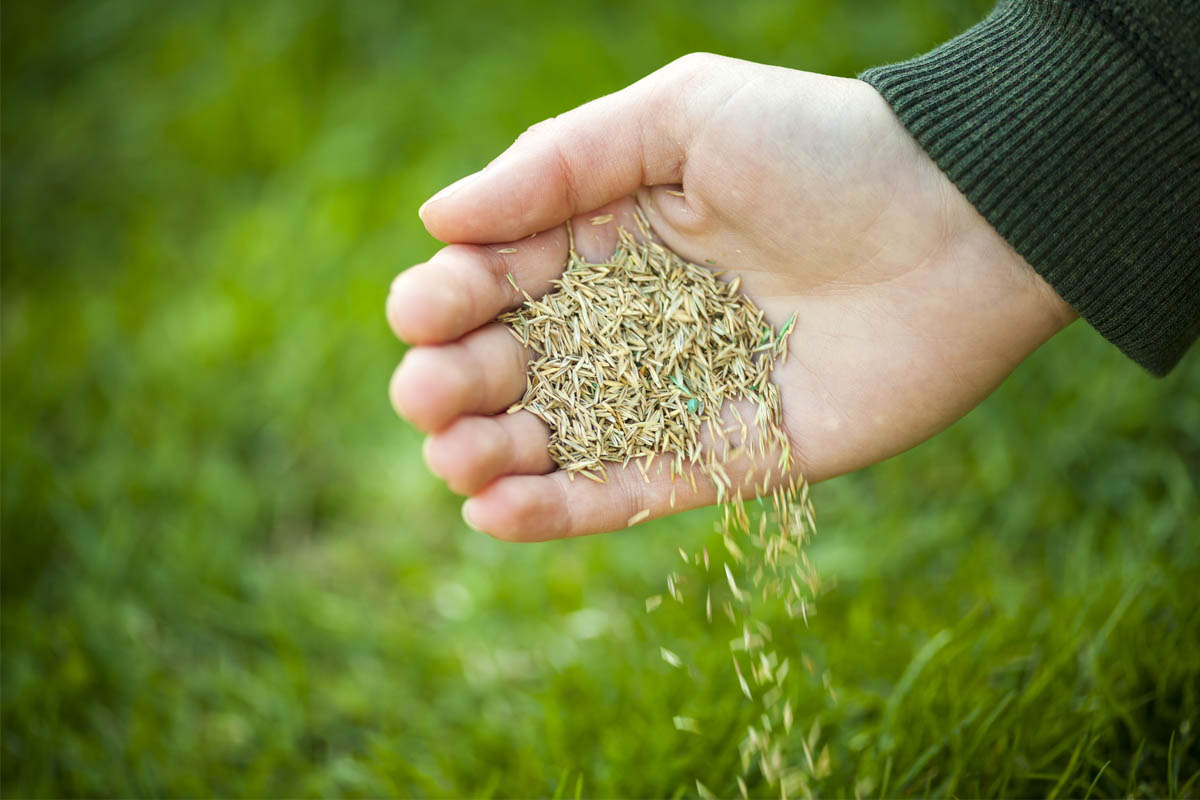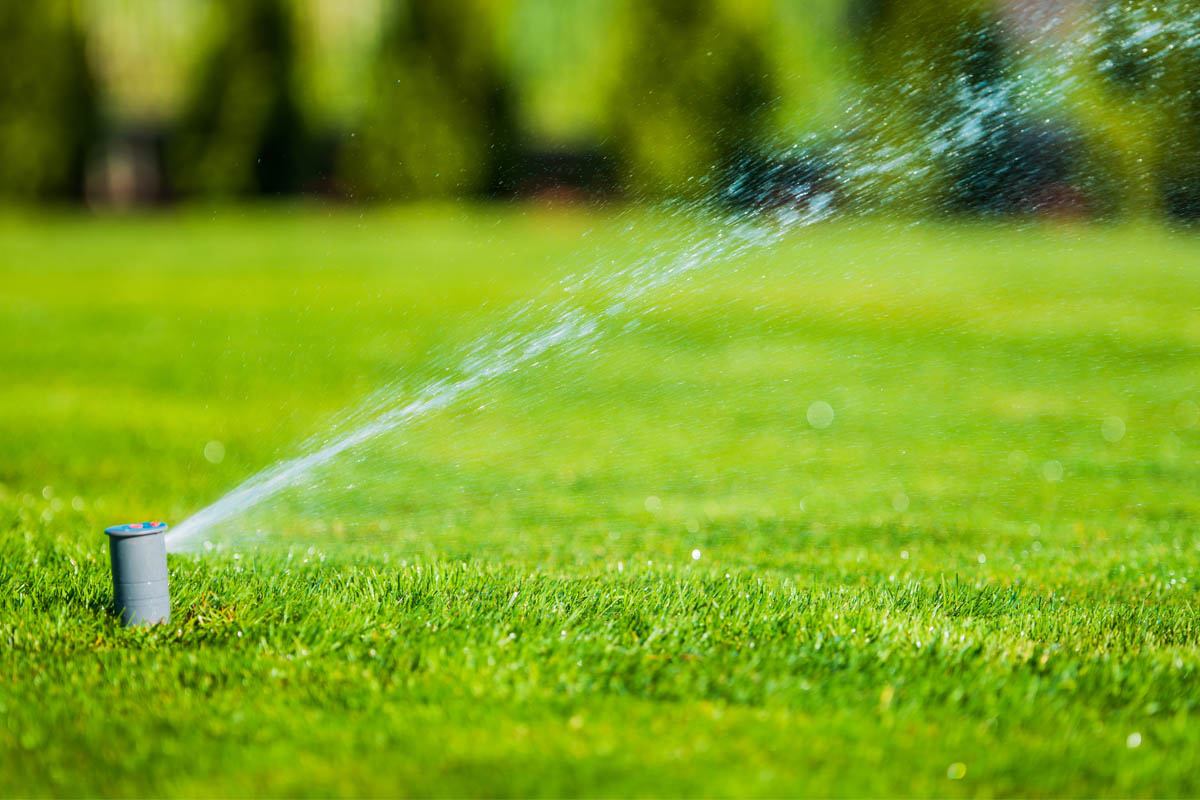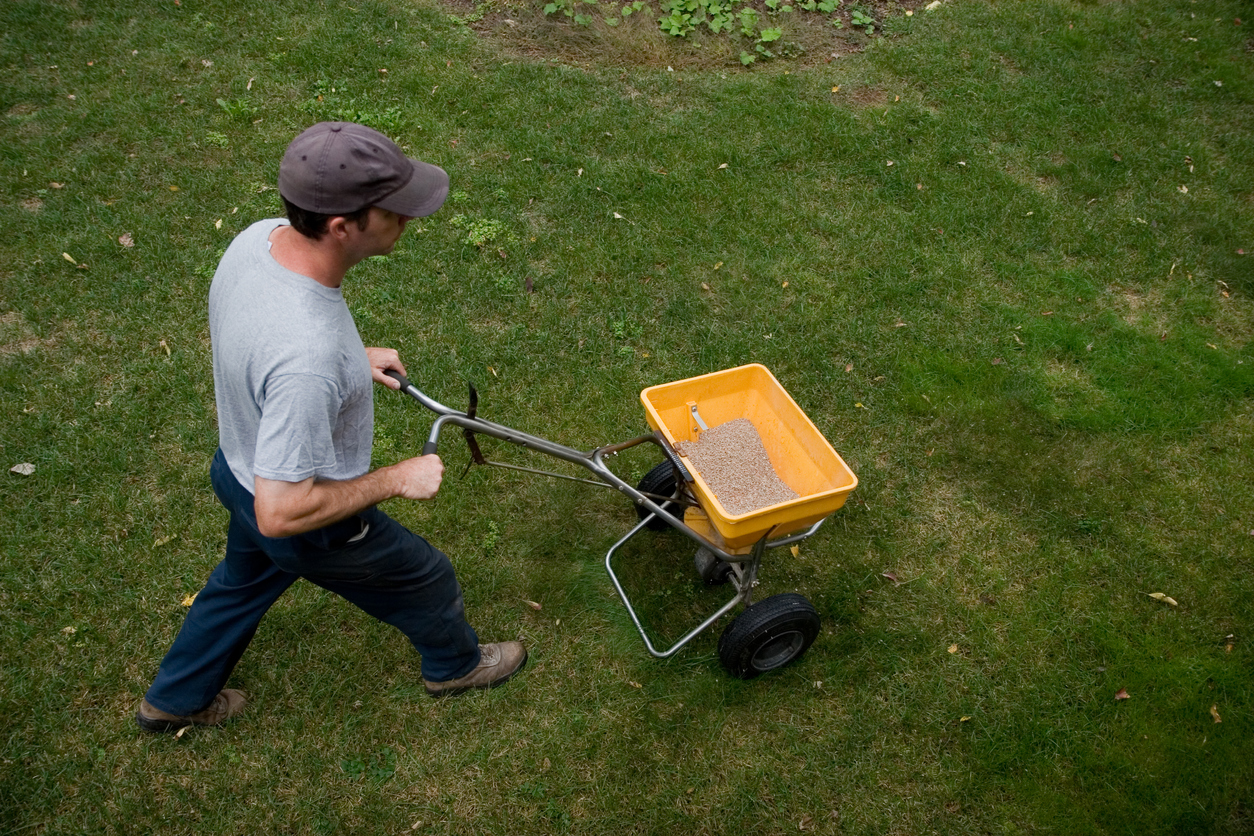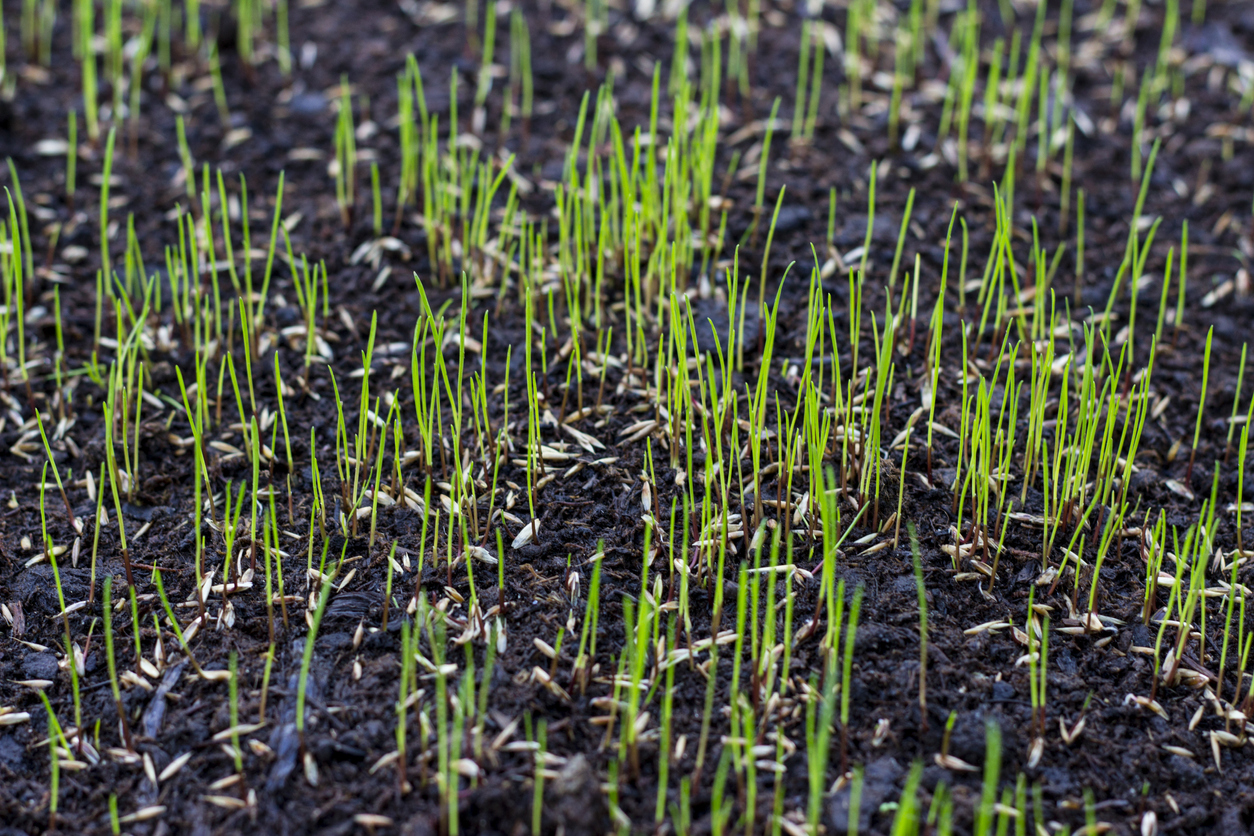We may earn revenue from the products available on this page and participate in affiliate programs. Learn More ›
Q: I recently had work done in my yard that left a large area of bare soil. If I reseed the area, how long will it take to grow new grass?
A: We all want a good-looking lawn around our homes, but not everyone wants to spend hundreds or even thousands of dollars installing sod. Planting grass seed is a budget-friendly way to repair a damaged lawn or establish a new lawn. Although starting from seed won’t give you immediate gratification, in favorable conditions grass grows from seed to lawn in about 2 months.

Growing Grass Year-Round
Overseeding a summer (warm-season) grass with a cool-season grass for fall and winter can give your lawn year-round green. Time of year, growing zone, and grass type all affect grass seed germination time and the steps you use to achieve year-round turf. The tips below (and help from a local source) can help you choose the best time to plant grass seed throughout the year.
Cool-season grasses grow quickly.

The fastest grasses to grow from seed are the cool-season grasses. These grasses grow best when soil temperatures are between 50 and 65 degrees Fahrenheit, which corresponds with air temperatures between 60 and 75 degrees. With proper care, all of these grasses can grow from seed to lawn in as few as 30 days. Here are grass seed germination times for some popular cool-season types.
- Annual or perennial ryegrass: 5 to 10 days to germinate
- Kentucky bluegrass: 7 to 10 days to germinate
- Tall fescue: 7 to 12 days to germinate
Warm-season grasses take more time.
Due to longer germination time and the amount of time it takes for root development, warm-season grasses grow more slowly than cool-season grasses. As you might expect, warm-season grasses like it hot. Cold weather can interrupt the germination process and possibly kill young grass plants.
For the fastest germination, warm-season grasses need soil temperatures between 60 and 75 degrees Fahrenheit, and daytime temperatures that are consistently above 80 degrees. While these grasses may be tall enough to mow within 2 months of seeding, full, dense establishment takes up to a year. Common warm-season grasses and their germination times are:
- Bermuda grass: 10 to 30 days to germinate
- Zoysia grass: 14 to 21 days to germinate
- Centipede grass: 14 to 21 days to germinate
- Buffalo grass: 14 to 30 days to germinate
How fast your grass will grow depends on several factors, one of which is the type of grass you are planting. Sunlight, time of year, site preparation, age of the seed, and irrigation all affect how quickly grass seeds sprout and become established.
Checking with local sources can keep you from overseeding warm-season lawns with cool-season grass seed too soon. If temperatures are still warm, your warm-season grass will thrive enough to keep the cool-season grass from getting established.
RELATED: The Best Things You Can Do for Your Lawn

Grass needs full sun to grow best.
Grass grows best in full sunlight. As soon as the grass seeds sprout, the tiny leaves begin using that sunlight to make energy that grows deep roots and lush leaves. If there’s plenty of light, grass plants grow full and fast. If there is too much shade, the lawn will grow sparsely. Before planting grass seed, make sure the area receives at least 6 hours of full, direct sunlight each day, or choose a shade seed mix if that’s not possible.

Plant grass seed at the right time of year.
The time of year you choose to plant grass seed matters, and depends on the type of seed you are using.
- Plant cool-season grasses while temperatures are cool and when they will remain cool for a couple of months so that the lawn can become well established before the weather heats up. For many of us, that means late summer or fall, or possibly later winter. For some, it means spring.
- Warm-season grasses, on the other hand, should be planted in late spring or early summer. They take a long time to germinate, and that time must not be interrupted by a late cold snap. But don’t wait too long! These heat lovers need to be well established before the first frost in fall.
RELATED: Make Your Neighbors Green With Lawn Envy Thanks to Our Favorite Grass Seed

Grass Seed Germination Time
The actions you take in preparing the ground and caring for your new seeds also affect grass seed germination time. Growing grass is more successful when you take care to prepare the planting area and water seeds consistently.
Prepare the soil before planting, and be sure protect new seeds.
Whether you are repairing an existing lawn or planting a new one, site preparation is key. Kill any existing weeds, but take care: There is usually a recommended wait time between applying chemical weed killers and seeding new grass. Each product is different, so follow the manufacturer’s directions.
Create a hospitable root zone for the new grass seedlings by spreading a 1- to 2-inch layer of compost and tilling it into the top inch of soil. Rake out a smooth seed bed, removing rocks and other debris. After spreading grass seed, cover the area with a thin layer of straw mulch, and then avoid foot traffic until the first mowing.
When overseeding an existing lawn, be sure to check the grass seed package directions or local sources about turf common to your area. Typical instructions are to gradually prepare the existing lawn to favor growth of seed, and lightly rake the new seed into the existing lawn.

Water grass seeds consistently.
Watering new grass seed is probably the most important factor in speedy development. Beginning on the day you spread the seed, water daily with your irrigation system or a hose-end sprinkler until it has germinated. At this stage, your goal is to keep the soil surface moist.
Do not water grass seeds to the point of runoff or pooling; this could wash away the seeds before they have a chance to root. Depending on your soil and slope of the landscape, you may have to water two to four times daily for only a few minutes each time.
RELATED: The Best Oscillating Sprinklers for Lawns of All Sizes, Tested

After the grass seeds germinate, your goal is to promote deep root development. Gradually decrease the frequency of watering and increase the duration. Here’s how that may look:
- Days 1 (seeding day) to 14 (germination observed): Water for 15 minutes four times each day.
- Days 15 to 21: Water 30 minutes one time each day.
- Days 22 to 28: Water 40 minutes one time on alternate days.
- Days 29 and beyond: Water 45 minutes three times per week, or enough to deliver 1.5 inches of water per week (skip watering when you receive sufficient rainfall).
The type of lawn sprinklers you use, climate variables, soil types, and grass types will all affect watering requirements. Contact your county’s Cooperative Extension Service for detailed guidance on lawn irrigation in your area.
Your beautiful new green lawn will be walkable and mowable when the grass is 4 inches high. Don’t mow too soon! Mowing before the grass is fully established slows root development and could ruin your hard work. Your lawn will continue to grow thicker as long as growing conditions are favorable.
RELATED: The Best Tall Fescue Grass Seeds for a Lawn That Will Turn Heads

Final Thoughts
Knowing how to grow grass from seed can make this landscaping activity more fun than frustrating. Time the grass planting according to the grass type and expected or average temperatures. Prep the soil for grass-growing success and water consistently. These efforts can improve germination rate and time along with the health of your new lawn.
Growing grass from seed takes a little longer than laying sod or planting plugs. But it saves money and can be rewarding. Just be patient; how long it takes the grass to grow from seed can vary. Depending on grass type, you can grow a new lawn from seed in 30 to 60 days.

FAQs About Growing Grass
Growing a new lush lawn or overseeding a seasonal grass depends plenty on the types of grass, growing zone, and your care. Here are common questions about growing grass seed and the answers.
Q. How often do you water new grass seed?
Watering new grass seed is the most important factor in getting grass seed to germinate. You might need to water up to four times a day for the first 2 weeks, gradually reducing how often you water but increasing how long the sprinklers run. Seeds need even moisture, but take care to avoid watering so much that water pools or runs off a hill, taking the grass seed along.
Q. When should I mow new grass seed?
Not all seeds germinate at the same rate, so give the entire seeded area time to come in before even considering mowing. Once germinated, the new grass is still growing roots below the ground, needing energy from the blades you see to support root growth.
It’s tempting to mow your pretty new lawn right away, but wait at least 2 months to mow newly seeded lawns; at that point, the grass should be at least 4 inches long.
Q. Will grass seed grow if I just throw it down?
If you really want your new grass seed to grow, you have to put in a little more effort to make sure you establish healthy, even turf. Site preparation and efforts like mulching help grass seeds germinate and establish healthy soil to support young grass.
Adding a layer of compost also helps germinated seeds grow strong roots, which is essential to grass health. Some seeds will sprout if you just throw them out, but the coverage will not be even and the grass will not be as healthy as it will be if you take time to prep the soil.


